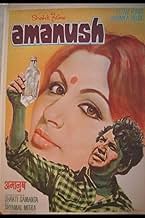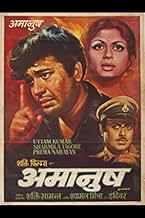गांव के एक युवक को झूठे षड़यन्त्र में फंसा कर जेल में डाल दिया जाता है और वह अपनी प्रेयसी के सामने अपनी बेगुनाही साबित नहीं कर पाता. तबाह हो जाता है, वह शराब लेता है.गांव के एक युवक को झूठे षड़यन्त्र में फंसा कर जेल में डाल दिया जाता है और वह अपनी प्रेयसी के सामने अपनी बेगुनाही साबित नहीं कर पाता. तबाह हो जाता है, वह शराब लेता है.गांव के एक युवक को झूठे षड़यन्त्र में फंसा कर जेल में डाल दिया जाता है और वह अपनी प्रेयसी के सामने अपनी बेगुनाही साबित नहीं कर पाता. तबाह हो जाता है, वह शराब लेता है.
- पुरस्कार
- 3 जीत और कुल 5 नामांकन
- Pujari
- (as Asit Sen)
- Jyoti
- (as Subroto)
कहानी
क्या आपको पता है
- ट्रिवियाWhen Shakti Samanta decided to make the film Amanush in both Bengali and Hindi, Rajesh Khanna expressed to Samanta his willingness to play the lead in Hindi. But Khanna being too busy asked Samanta to delay the shooting by a few months for the Hindi version, but Samanta thought he could make both versions easily if Uttam Kumar himself starred in the Hindi version too. Rajesh Khanna was very disappointed on having lost this role just because of date issues.
- भाव
Lekha: How can a beastly man like you be an inspiration to these kids? Have you ever thought of it?
Madhusudan Roy Chaudhary 'Madhu': Am I a beast? I am a low lorn man... but have you ever thought... .that your hatred has turned me into a man with vices
- कनेक्शनReferenced in Taarak Mehta Ka Ooltah Chashmah: Choco Moco in Garbage! (2012)
- साउंडट्रैकNadiyon Mein Lehre Nache
Music by Shyamal Mitra
Lyrics by Shyamalal Babu Rai
Performed by Shyamal Mitra
Considering the yawning-gap in nature of Bengali and Hindi films back then, it was a welcome move when he decided to make this bilingual. One expected this film to introduce the brand of potboiler-entertainment of Bollywood in an otherwise monotonous Tolly-world. But instead this turned out to be a typical Tolly-venture: deglam and boring!
Being a Bangalee, this film presented the big attraction of getting to watch Uttam Kumar in a Hindi film. Besides hearing him speak in Hindi, I was also keen to check out his action and dancing skills, which were completely untested in Bengali films. Although he managed the dialogues (even though it was clear that he's a non-Bengali), the dancing and fights left a lot to be desired. Even though he didn't get any proper dance-number, the little jig he performed in a Holi-sequence was scary enough (it almost brought back the memories of the 'Chotisi Mulakat' title-track)! But credit must be given for even at 50 he maintained a physique that was much beyond his years.
The film has all the elements of a proper Bollywood venture; but not in the right quantity. The film is extensively shot in the Sunderbans, which creates an extremely deglam and unattractive ambiance for the film. Compared to the glamorous Mumbai or the colourful countryside we are habituated to see in Hindi films, the sight of Sunderbans is a total turn-off from the start! The sets are also quite substandard. The script lacks the regular doses of comedy, tragedy and romance making the film boring, compared to an average Hindi film of the 70's. Even the fight- sequences are a big let-down; especially the climax (which is shot in broad-daylight, even though it's supposed to be night-time)!
But when one compares this to the average Bengali fare of those days, then the film assumes a completely different avatar altogether. However unattractive Sundarbans might be for the Bollywood viewers, it offers a welcome relief for the Bengali cine-goers who were condemned to the same old sight of Kolkata and the rustic croplands of Bengal. The script with its limited doses of action and revenge is far more engaging than the routine romantic family dramas of those times. And above all it's a colour film; which was gold-dust back then!
The cast comprises entirely of Bangalee artistes; majority of them unfamiliar to the pan-India audiences. Performance-wise it's Utpal Dutt who steals the show as the archetypal baddie. But in terms of Hindi pronunciation, it's Anil Chatterjee who impresses the most.
Considering R.D.Burman's rapport with Samanta, it's baffling why he wasn't considered for this film as he could have handled both versions with aplomb. Shyamal Mitra did a commendable job for the Bengali version delivering hits like 'Ki Ashay Badhi Khelaghor' and 'Jodi Hoi Chorkata'. But in the Hindi version, it's only 'Dil Aisha Kisine Mera Tora' which manages to click. The other songs are too Tollywoodish; lacking the Bolly feel. The background score also impresses only sporadically.
It seems the film was consciously trying to obey the prevalent standards of Bengali cinema; instead of trying to challenge it as I had hoped. This was baffling considering Samanta's reputation for making mass-entertainers in Bollywood. Perhaps the costs of making a double- version forced him to curtail the overall budget; which compromised the film's grandeur and luster.
The aforementioned points ensured the Bengali-version became a monster hit in West Bengal. The low-costs ensured that even the Hindi version did well. This sparked off a trend of making bilinguals in Bollywood, with Samanta himself churning out 'Ananda Ashram' and 'Barsaat Ki Ek Raat'; which were far better than this. Overall, the film is a decent watch by Bengali standards; but a big let-down for the Shakti Samanta loyalists!
- sumankumarganguly-454-264875
- 19 मार्च 2014
- परमालिंक
टॉप पसंद
- How long is Amanush?Alexa द्वारा संचालित
विवरण
- चलने की अवधि2 घंटे 33 मिनट
- रंग
इस पेज में योगदान दें






















